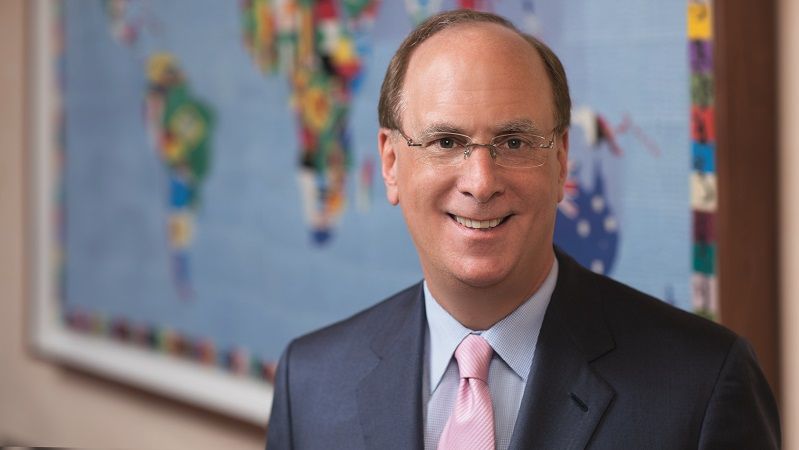Last week Blackrock launched a range of multi-asset ESG ETF portfolios, which it claims are the first in Europe.
It was a clear sign that the ESG ETF market is picking up pace across the continent: can it steal a march on the active industry, or is there room for both?
Shifting gears
The trend to passive ESG options is gaining momentum. In a recent interview, Blackrock chief executive Larry Fink (pictured) pointed out that $12bn (£9.3bn) of client assets went towards ESG ETFs in 2019; in the first half of 2020, this had risen to $17bn.
He said: “There has been a surge of interest in clients looking to put money into renewable components of energy and that surge will continue.”
This echoes a recent survey of European institutional investors by Invesco. It showed 45% of the respondents saying they planned to increase the amount they invest in ESG ETFs in the next two years.
In contrast, just 5% intend to cut passive exposure.
More than half said the majority of their ESG investments would be managed passively within the next five years.
If this happens, it would be a major shift: as it stands, somewhere between 6% and 10% of the market is currently passive.
Amundi says it has noticed the resilience of ESG ETFs during the crisis.
Matthieu Guignard, global head of product development and capital markets at the group, says that while equity ETF strategies have been shedding assets overall, funds with an SRI/ESG tilt have more than compensated.
Passive limitations
There is a question as to whether this eats the lunch of active investors, who have long argued that the thin margins of ETFs don’t allow them to do sustainability properly.
Passive groups have been criticised for outsourcing voting to third parties rather than engaging with companies directly on climate issues.
Equally, a passive manager cannot divest from a company if it continues to form part of the index, which gives them limited leverage.
Flows into active funds are still relatively robust, suggesting there is room for everyone. In July, Morningstar reported that net flows into sustainable vehicles totalled £1.2bn, with 57% of that going into equity funds, split 50/50 between passive and active vehicles.
Equally, ESG ETFs represent only a fraction of the overall European ETF market, so it may be that some assets will switch from existing passive options.
Either way, a recent report into this part of the market from Create Research, Passive Investing 2020: Addressing climate change in investment portfolios, suggests there is still a big pot to go for: “22% of our survey respondents have allocations in excess of 15% when it comes to all climate-related strategies.
“At the other extreme, 19% have no allocations at all currently. In between, 43% have allocations less than 5%; and 16% have between 6% and 15%.”
In other words, if the market goes where people think it is going, there will be a lot of money in motion and both active and passive ESG strategies can thrive.
Best in class
Where money has been going into ESG ETFs, it has tended to follow familiar lines.
Amundi says the largest share goes into equities and mainly into global world indices. North America gets another chunk, followed by Europe and emerging markets.
Guignard adds: “The ‘best in class’ approach dominates, taking around half of net new assets. The most popular specialist funds are the climate approach.”
That said, there are considerable regional differences across Europe. Southern European investors tend to be less demanding in their approach. Northern European pension funds, particularly those in the Nordics, have the greatest demand for SRI products and are also more specific in their approach.
“The south of Europe goes for a lighter approach. We now have three levels of SRI intensity to cover all these demands.”
Paris-aligned
The next hot topic, he believes, will be climate change funds. From the Paris Climate Agreement to the European Green deal, there is considerable funding moving in the direction of climate change solutions and the energy transition.
This is likely to spur investor interest in green solutions.
This is already happening. At the end of last year, Caisse des Dépôts, EDF, and 10 major French insurers launched a process to select three management companies – ultimately announced as Amundi, HSBC Gam and Sycomore – to help them combat global warming through the development of investment solutions aligned with the goals of the Paris Agreement.
These investment solutions will be aligned with the future European “Paris Aligned Benchmark” label, which ensures investors’ portfolios are aligned with the Paris Climate Agreement
The ESG ETF market is enjoying a buoyant moment.
Investors have increasingly focused on environmental, social and governance issues, with the Covid-19 outbreak compounding pressure from regulators and investors. The products are now in place.
However, the active management industry shouldn’t panic just yet. The market is likely to be big enough for everyone.








